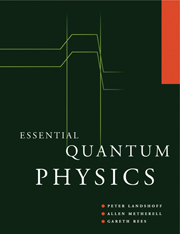Book contents
- Frontmatter
- Contents
- Preface
- Constants of quantum physics
- 1 Preliminaries
- 2 The Schrödinger equation
- 3 Special solutions
- 4 The superposition principle
- 5 The hydrogen atom
- Revision quiz
- 6 The hydrogen molecule
- 7 Introduction to perturbation theory
- 8 Spin
- 9 Masers and lasers
- 10 Band structure of crystals
- 11 Electron motion in crystals
- 12 Transistors
- Appendices
- Hints for the problems
- Index
12 - Transistors
Published online by Cambridge University Press: 05 June 2012
- Frontmatter
- Contents
- Preface
- Constants of quantum physics
- 1 Preliminaries
- 2 The Schrödinger equation
- 3 Special solutions
- 4 The superposition principle
- 5 The hydrogen atom
- Revision quiz
- 6 The hydrogen molecule
- 7 Introduction to perturbation theory
- 8 Spin
- 9 Masers and lasers
- 10 Band structure of crystals
- 11 Electron motion in crystals
- 12 Transistors
- Appendices
- Hints for the problems
- Index
Summary
Impurities
We have so far described the properties of intrinsic semiconductors, in which the crystal lattice is perfectly regular. However, the electrical properties of semiconductors, unlike metals or semimetals, are drastically affected by the addition of small traces of impurity atoms. Observable effects occur with impurity concentrations as low as a few parts in 108, and increasing the impurity concentration to one part in 105 can increase the conductivity by as much as a factor of 103 at room temperature and 1012 at liquid-helium temperatures. The semiconductor is said to be doped with impurity atoms.
In order to study the effect of doping, we first consider a crystal consisting of a periodic array of one type of atom, except that just one of the atoms has been replaced by an atom of a different type. As a one-dimensional model of this situation, we take the same infinite chain of square wells as in chapter 10, but with one of the wells having a different depth, U1 say (figure 12.1).
We recall that for the perfectly regular crystal, the stationary state solutions are Bloch waves of the form (10.3). These have the property that when the required continuity conditions on the wave function are satisfied at the two edges of one of the potential wells, they are automatically satisfied also at the edges of all the other wells.
- Type
- Chapter
- Information
- Essential Quantum Physics , pp. 141 - 157Publisher: Cambridge University PressPrint publication year: 1997

